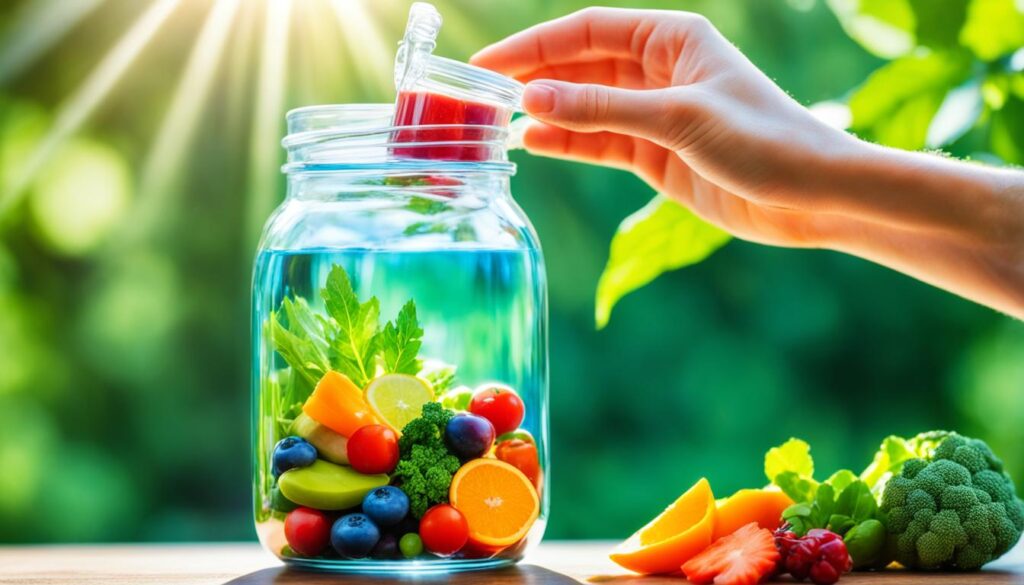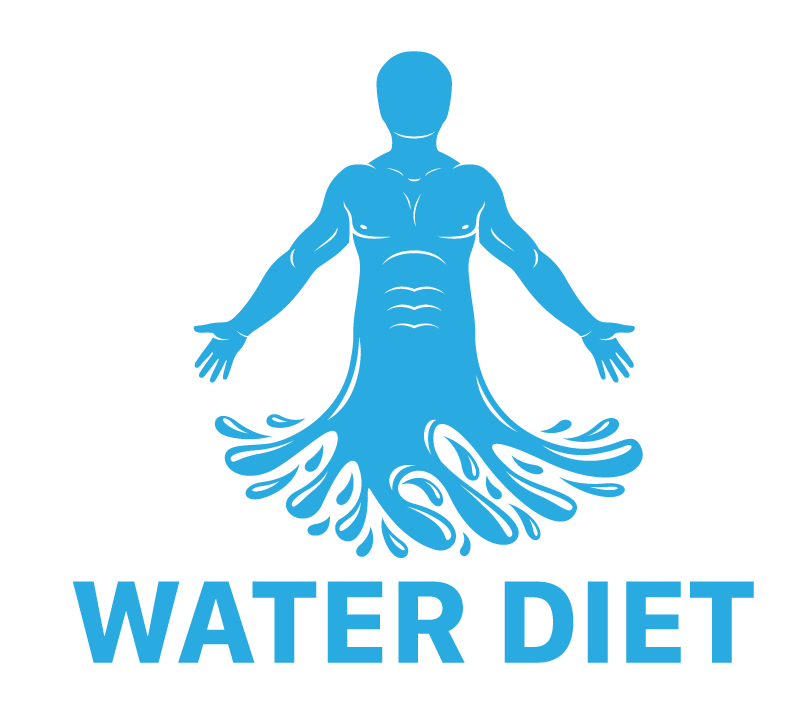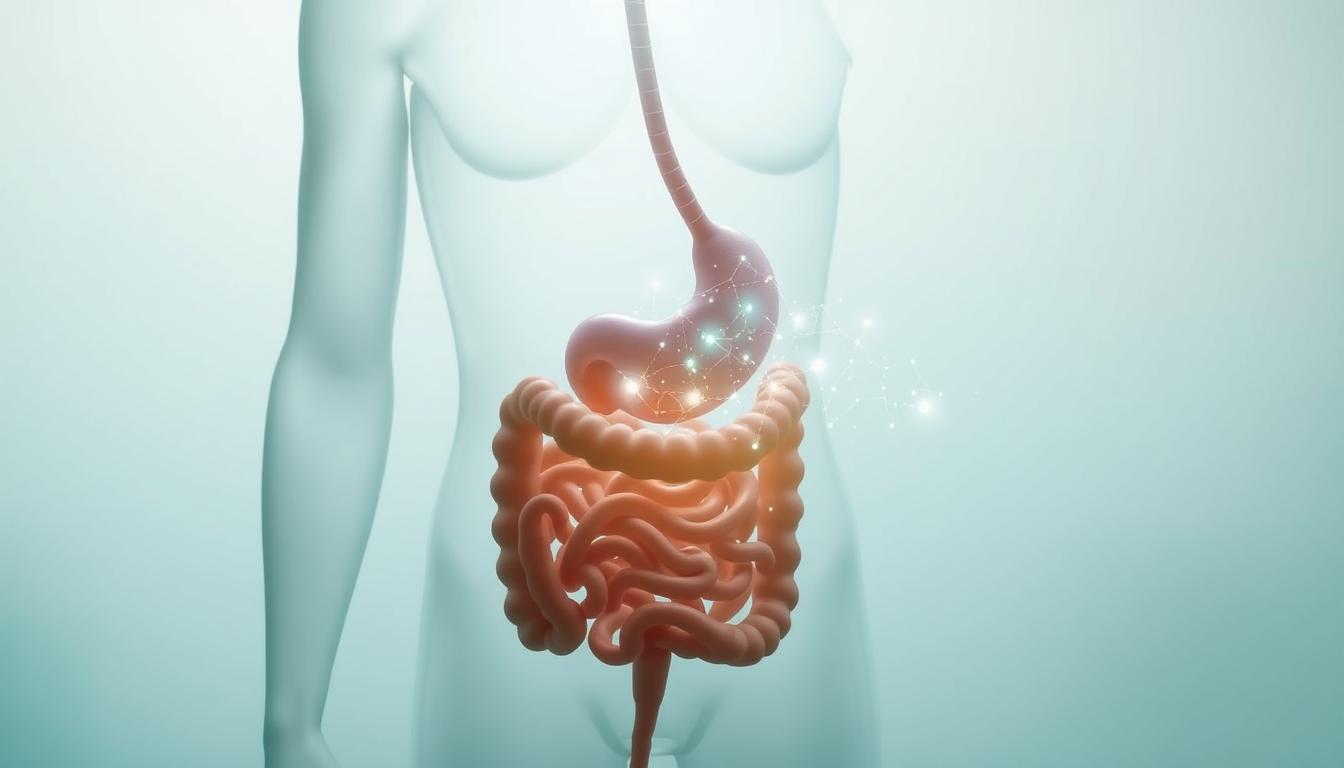Starting a water fast aims to improve our health and well-being. But, it’s key to know how to end it safely to avoid problems and smoothly return to eating normally. Whether your fast lasts a few days or longer with a doctor’s advice, adding food back into your diet should be thoughtful.
Long fasts change our body a lot, affecting our metabolism and digestion. That’s why it’s vital to follow expert advice on water fasting and safe fasting tips. Slowly adding back foods that are full of nutrients, staying hydrated, and keeping electrolytes in balance are important steps. Doing this right helps us dodge stomach issues and health dangers like refeeding syndrome.
Studies reveal most people fast for 2-3 days, which helps lower stress, improves hydration, and aids in losing weight. Longer fasts should always be done with a doctor’s watchful eye. To safely end a water fast, planning and following expert advice are crucial.
Key Takeaways
- Breaking a water fast safely means slowly adding food back in.
- It’s important to keep hydrated and balanced with electrolytes after fasting.
- Stay away from processed and fatty foods right after fasting.
- Watch how your body reacts to new foods to avoid discomfort.
- Following safe fasting tips helps ease back into regular eating habits.
Why Breaking a Water Fast Safely Is Important
Breaking a water fast safely is key for our health. It’s a critical step that helps our body adjust after fasting. Doing it right can prevent health issues.
Impact on Digestion
Our digestive system needs care when breaking a fast. After fasting, it’s very sensitive. Diets like the lemon detox cleanse need a slow return to eating.
Eating too much too soon can cause bloating and discomfort. It’s important to ease back into eating. This helps our body get used to digesting food again without stress.
Preventing Refeeding Syndrome
Preventing refeeding syndrome is also crucial. This happens when our body’s fluids and electrolytes get out of balance during refeeding. Starting with small, nutrient-rich foods helps avoid this.
Refeeding syndrome is a big concern after long fasts or for people with health issues. Our breaking fast safely tips suggest watching how we start eating again. It’s also key to drink plenty of water because fasting can make us dehydrated.
Let’s follow a good plan to ease back into eating safely. This keeps our health in check.
| Risk Factors | Preventive Measures |
|---|---|
| Digestive Distress | Gradual food reintroduction |
| Refeeding Syndrome | Monitoring electrolyte levels, starting with small meals |
| Dehydration | Regular hydration |
What to Expect After a Water Fast
Finishing a water fast is a big deal, but knowing how to transition back is key. Our bodies change a lot during a fast, leading to some common symptoms when we stop fasting. Let’s look at these changes and symptoms closely.
Metabolic Changes During a Fast
A water fast can last from 24 to 72 hours. In this time, our bodies switch to using fat for energy since we’re not eating carbs. This shift can lead to increased autophagy, which helps slow down aging and make us live longer. Studies show that fasting can lower blood sugar and insulin levels, making insulin resistance better.
It also helps reduce triglyceride and cholesterol levels and cuts down body fat. These changes show fasting can be good for the heart and help with weight control.
Common Symptoms When Breaking a Fast
When we stop a water fast, our bodies go through some changes. We might feel mood swings, get hungry, or notice changes in our energy. Some people might feel a bit dizzy or have stomach issues as digestion gets back to normal.
To handle these symptoms, it’s important to follow post-fast transition tips and fast carefully. Drinking diluted fruit or vegetable juice, broth, and light soups can help ease the transition. Knowing about these changes and symptoms helps us manage our post-fasting period better and enjoy the health benefits of water fasting.
How to Break a Water Fast Safely: Tips and Recommendations
Breaking a water fast the right way is key to avoiding bad effects and smoothly going back to eating normally. Let’s look at some safe fasting recommendations for safely ending a water fast.

Introduce Foods Gradually
For fasts over 7 days, take at least four days to ease back into eating. Shorter fasts need one to three days. Start with liquids like bone broth or apple cider vinegar. Then, slowly add solid foods, like boiled potatoes, pears, or steamed veggies.
- Start with clear liquids such as bone broth or diluted juices.
- Move to soft fruits and vegetables.
- Incorporate small portions of protein like scrambled eggs or fish.
Avoid Overeating
Eating too much after a fast can lead to bloating and slow down digestion. Chew each bite 20 times to help digestion. Here are some water fast ending tips to avoid eating too much:
- Divide your meals into smaller portions and space them throughout the day.
- Follow an eating schedule that includes 3 meals and 2 snacks daily.
- Listen to your body’s signals of fullness to prevent overconsumption.
Monitor Your Body’s Response
Watch how your body reacts when you end a fast. Issues like diarrhea, gas, and constipation are common. To make the transition smoother, follow these safe fasting recommendations:
| Symptom | Recommendation |
|---|---|
| Diarrhea | Stay hydrated and consume small, easily digestible meals. |
| Gas | Avoid high-fiber foods initially and introduce them gradually. |
| Constipation | Increase fluid intake and include lightly steamed vegetables. |
By using these water fast ending tips, we can safely return to regular eating. The key is to slowly add foods, avoid eating too much, and watch how your body feels.
Best Foods to Break a Water Fast
When you end a water fast, it’s important to slowly add nutrients back into your diet. Start with foods that are easy to digest and hydrating. This helps your body adjust smoothly. Here are some top foods to consider as you start eating again.
Gentle Foods for Reintroducing Nutrients
Start with foods that are light and full of nutrients. Smoothies, soups, and steamed veggies are great choices. They’re easy on your stomach and full of vitamins and minerals.
Fermented foods like unsweetened yogurt are good for your gut. Healthy fats in avocados and eggs give you energy without being hard to digest.
Sample Meal Plan
Creating a meal plan can help you smoothly transition from fasting to eating normally. Here’s a list of drinks and meals to get you started:
- Begin with hydrating beverages:
- Green tea
- Watermelon juice
- Bone broth
- Coconut water
- Black coffee
- Move on to gentle solid foods:
- Unsweetened yogurt
- Smoothies
- Soup (like lentils or vegetable noodle soup)
- Eggs
- Nuts
As you get used to eating again, you can slowly add more complex foods. Remember, the aim is to ease back into regular eating while still focusing on easy-to-digest foods.
Foods to Avoid Post-Fast
After a water fast, it’s key to be careful with what we eat. Our body is sensitive, and the wrong foods can cause stomach problems or make blood sugar levels go up. Let’s look at the foods to avoid for a smooth return to normal eating.
High Fat Foods
Stay away from high-fat foods like fried or greasy ones after a fast. These can be hard on your stomach, leading to discomfort or indigestion. Healthy fats like avocados and olive oil are good, but eat them slowly and in small amounts.
Processed Foods
Also, avoid processed foods. They often have additives, preservatives, and refined sugars that can upset your stomach after fasting. Choose whole, healthy foods as advised by fasting experts for a smoother return to eating.
Sugary Snacks
Sugary snacks and drinks can quickly raise and then drop your blood sugar levels. This is not good after fasting. Avoid sweets, candies, and sugary drinks. Instead, try foods like berries or watermelon, which are naturally sweet and easier on your system.
By following these tips and being careful with what you eat after a fast, you can enjoy the benefits without the bad side effects. For more advice on safely ending a water fast, see this detailed guide on how to safely break a water fast.
Understanding Refeeding Syndrome
Refeeding syndrome is a serious condition that can happen after a long fast or not eating enough. It’s important to know the signs and how to prevent it for safe fasting.
What Is Refeeding Syndrome?
Refeeding syndrome is a condition marked by severe changes in electrolytes, fluid retention, and sometimes organ problems. It happens when the body gets a lot of nutrients too quickly after fasting, causing electrolyte and fluid shifts. Studies show that it often leads to low levels of phosphorus and potassium as eating habits return.
Symptoms and Risks
It’s key to spot the symptoms early. Look out for weakness, bloating, and heart racing. Nutrient shortages, especially in potassium, phosphorus, magnesium, and thiamine, are big factors. Refeeding syndrome can cause serious issues like seizures, heart failure, and comas.
People at high risk include those with a BMI under 16 or who’ve lost over 15% of their weight recently.
Preventive Measures
To prevent refeeding syndrome, we need a careful plan when starting to eat again. Here are some tips for healthy fasting:
- Identify At-Risk Individuals: Keep a close watch on anyone fasting for more than five days.
- Gradual Refeeding: Start with small amounts of nutrient-rich foods like green juices and bone broth. Avoid heavy carbs at first.
- Supplementation: Use supplements like magnesium, B vitamins, vitamin C, and potassium to keep nutrients balanced.
- Monitor Electrolytes: Check blood levels often to keep an eye on and adjust electrolytes as needed.
- Incremental Caloric Intake: Slowly increase calories, starting with about 20 calories per kilogram of body weight.
Following these steps helps prevent refeeding syndrome. It’s important to plan carefully and pay attention to each person’s health needs after fasting.
Adding these steps to our routines ensures a balanced and smooth return to normal eating habits.
Hydration and Electrolyte Balance
Keeping your body hydrated and balanced with electrolytes is key during and after fasting. Drinking mineral-rich water helps prevent dehydration. Eating broth can also help replace lost electrolytes. Staying hydrated supports your body’s metabolic processes and keeps you healthy, reducing the chance of negative effects after fasting.
Importance of Hydration
After fasting, it’s vital to drink water to help your body function normally again. Staying hydrated helps prevent dehydration and keeps your body running smoothly. Not drinking enough water can lead to dehydration, causing issues like dizziness and feeling tired. So, it’s important to drink plenty of water after fasting to recover well.
Electrolyte Replenishment
Keeping your electrolyte levels balanced is crucial during fasting to avoid health problems. Electrolytes like sodium, potassium, magnesium, and calcium are important for your cells, muscles, and nerves. They can get low quickly during fasting, so it’s important to watch and replenish them.
Using mineral-rich broths or supplements can help keep your electrolytes in check.
| Electrolyte | Function | Source |
|---|---|---|
| Sodium | Fluid balance, nerve function | Broth, mineral water |
| Potassium | Heart rhythm, fluid balance | Leafy greens, bananas |
| Magnesium | Energy production, biochemical reactions | Nuts, seeds |
| Calcium | Bone health, muscle function | Broth, leafy greens |
Start with a small amount of electrolytes and increase as needed to avoid side effects like vomiting or diarrhea. Talking to a healthcare provider can help you manage your hydration and electrolyte levels safely during fasting.
Post-Fast Transition Tips
Coming back to regular meals after a fast needs careful post-fast meal planning and paying attention to how we eat. By slowly adding more food, we can ease back into eating normally without upsetting our stomachs.
Gradual Increase in Meal Sizes
When you finish a fast, start eating again slowly. Begin with broths and liquids, maybe even on the first day. Aim for meals with no more than 500 calories at first, as suggested in post-fast meal planning. This approach helps avoid stomach problems and lets your body get used to solid foods again.
- Start with light fruits like watermelon or a smoothie.
- Incorporate foods that are low on the glycemic index.
- Increase portions slowly over several days to avoid shock to the system.
Listening to Your Body
It’s key to eat mindfully during this time. Pay attention to when you feel hungry or full. Chewing each bite 30 times helps with digestion and stops you from eating too much. This mindful eating can prevent overeating and make it easier to get back to regular eating habits.
If you fasted for a long time, know that your body changes. Hormones like growth hormone and insulin levels shift, affecting how you react to food again. Experts suggest starting with gentle foods like hemp seed oil, hemp hearts, or probiotics for your gut. Taking it slow when adding foods back into your diet can also be helpful.
Always talk to a doctor before ending a fast, especially if you have health issues. With careful planning and mindful eating, you can recover well and move towards better health.
| Transition Tips | Recommended Foods |
|---|---|
| Start with broths and liquids | Hemp seed oil, smoothies |
| Low glycemic index foods | Light fruits, probiotic supplements |
| Gradual increase in portions | Hemp hearts, bone broth |
Role of Supplements While Fasting
Fasting with supplements can help keep your nutrient levels up without breaking your fast. It’s key to know which supplements are good and which might not be. Some supplements can add calories or affect your metabolism.

Safe Supplements During a Fast
Some supplements are safe and won’t mess with your fasting:
- Creatine: It has no calories and doesn’t touch insulin levels, so it’s okay for fasting.
- Electrolytes: These supplements, without added sugars or calories, help with the side effects of ketosis.
- L-Tyrosine: Taking it on an empty stomach helps with stress and mood.
- Probiotics: These are good gut bacteria that you can take without eating.
- Prebiotics: They help keep your gut healthy and don’t need food.
- Water-Soluble Vitamins: Vitamins B and C are usually okay to take on an empty stomach during a fast.
For fasting longer than two days, it’s important to keep your electrolyte levels right. You need sodium (5000-7000mg), potassium (1000-3500mg), and magnesium (300-500mg) to stay healthy.
Supplements to Avoid
Some supplements can mess with your fast or reduce its benefits:
- Amino Acids: L-glutamine and BCAAs can make your insulin levels go up.
- Fat-Soluble Vitamins: These vitamins need fat to be absorbed and should be taken with food.
- Gummy Vitamins: These often have sugars and fillers that can end your fast.
- Protein Powders: They add calories and might change your fasting state.
When picking supplements for fasting, think about how they help with autophagy, ketosis, and fasting-induced adipose factor (FIAF). This way, you can get the most out of your fasting plan.
| Type of Supplement | Recommended Intake During Fasting | Reason |
|---|---|---|
| Creatine | Zero calories | Does not affect insulin levels |
| Electrolytes | No sweeteners or calories | Helps manage ketosis side effects |
| L-Tyrosine | Empty stomach | Aids in stress management |
| Probiotics | Without food | Supports gut health |
| Prebiotics | Without food | Supports a healthy gut microbiome |
| Water-Soluble Vitamins | B and C | Generally tolerated on an empty stomach |
| Amino Acids (L-glutamine, BCAAs) | Avoid | Can raise insulin levels |
| Fat-Soluble Vitamins (A, D, E, K) | With food | Requires fat for absorption |
| Gummy Vitamins | Avoid | Contains sugars and fillers |
| Protein Powders | Avoid | Adds calories |
Monitoring Health After a Water Fast
After a water fast, it’s key to keep an eye on our health to recover safely and effectively. We need to watch how our energy and thinking skills change. Our metabolism changes a lot during fasting, so knowing how our body reacts when we start eating again is crucial.
It’s also vital to check for signs of not getting enough nutrients or any symptoms that might mean we’re getting refeeding syndrome. A study with 12 middle-aged men showed big changes in their blood and urine after an 8-day fast. They lost weight and felt less stressed. But, about half of the people in another study had to stop fasting early because of headaches, feeling very tired, and a racing heart.
It’s a good idea to regularly talk to health experts to make sure we’re doing well. They can help us understand how our body is doing and guide us on what to eat. For more tips on safe water fasting, including when to stop and get help, check out this resource from PharmEasy.
Even though fasting can help with things like better blood sugar control and less inflammation, safety and health should always come first. By paying attention to our body’s signs, we can enjoy fasting’s benefits safely. This way, we can move towards our health goals in a healthy way.
Source Links
- Mya Care
- How to Break a Water Fast: 3 Helpful Tips
- Water Fasting
- What Breaks a Fast? Foods, Drinks, and Supplements
- Should You Try Water Fasting?
- What Is Water Fasting? Benefits, Risks And More
- How to Eat After a Short Water Fast | Livestrong.com
- How to Break a Fast (with Pictures) – wikiHow
- How to Fast Safely: 10 Helpful Tips
- Perform a Water Fast: Safe Guidelines for Beginners
- 10 Best Foods to Break a Fast
- What to eat (and drink) when you’re ready to chow down after a fast
- Best Foods To Break A Fast: Top 14 Foods That Make The Fast To Feast Transition Smooth
- Intermittent Fasting? Here’s The Right Way To Break Your Fast
- What to Eat After Fasting and What to Avoid to Reap the Benefits
- Refeeding After Your Prolonged Fast| Dr. Berg
- Everything You Should Know About Refeeding Syndrome
- Refeeding syndrome: what it is, and how to prevent and treat it
- Fasting Electrolytes
- Electrolytes For Fasting: Essential Tips For Maintaining Balance
- Electrolytes for Fasting
- 8 Stages of Water Fasting & 3 Fasting Tips | The Brothers Green
- Breaking Your Fast
- Can You Take Supplements While Fasting? What You Need to Know
- Fasting Supplements Guide
- Should You Supplement While Fasting? – Zero Longevity
- Water Fasting: Weighing the Benefits and the Risks
- No title found




